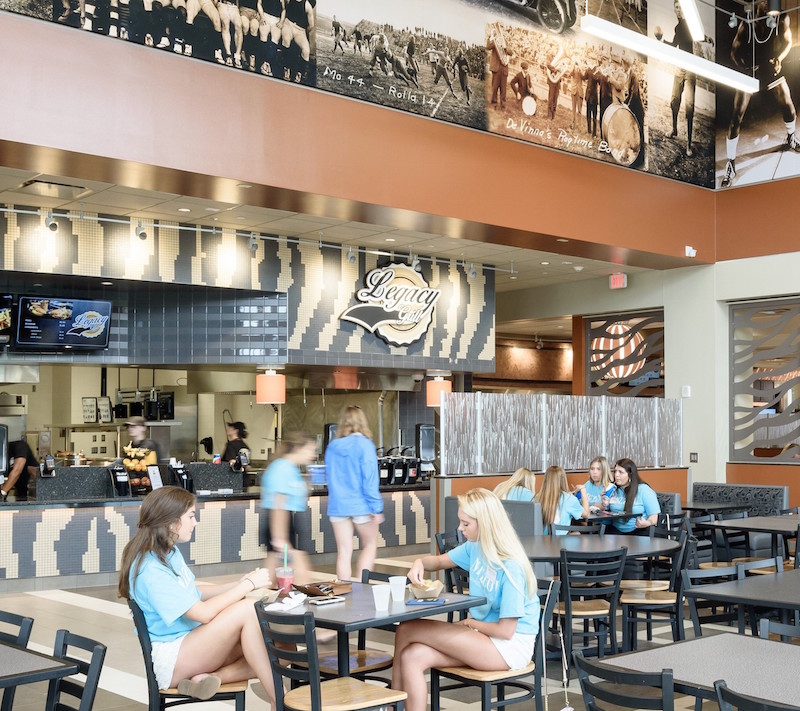There are a lot of things people remember fondly about their college days as they grow older, but the dining experience typically isn’t one of them. The Restaurants at Southwest, a new dining facility located on the University of Missouri campus, may never find itself in the memories of former students as they long for their halcyon college days, but it will be an upgrade over traditional college fare for the university's nearly 33,000 students.
The Restaurants at Southwest forgoes the traditional buffet-style, all-you-can-eat service found in most dining halls and replaces it with a la carte service, which lessens food waste and inventory. In addition to a separate Starbucks facility, the dining Hall’s six restaurant-style dining options include:
- Legacy Grill - Classic burgers, hand-cut fries, quesadillas, nachos and chicken sandwiches.
- Tiger Avenue Deli - Philly-style sandwiches prepared and served hot off the grill.
- Olive & Oil - Mediterranean-influenced pasta with house made pasta sauces.
- 1+5+3 Soups & Salads - Made-from-scratch, healthy soups and salads that offer students vegetarian, vegan, and allergy-friendly options.
- 1839 Kitchen - Comfort foods such as rotisserie chicken and other protein choices.
- Truffles - Desserts, smoothies, yogurt parfaits, bagels and other healthy snacks.
The $15 million dining facility and adjoining residence hall comprises 30,000 sf and can seat 600 people. The space was designed to be a social hub for the Dobbs residential neighborhood.
Related Stories
| Aug 11, 2010
Living and Learning Center, Massachusetts College of Pharmacy & Health Sciences
From its humble beginnings as a tiny pharmaceutical college founded by 14 Boston pharmacists, the Massachusetts College of Pharmacy & Health Sciences has grown to become the largest school of its kind in the U.S. For more than 175 years, MCPHS operated solely in Boston, on a quaint, 2,500-student campus in the heart of the city's famed Longwood Medical and Academic Area.
| Aug 11, 2010
Giants 300 University Report
University construction spending is 13% higher than a year ago—mostly for residence halls and infrastructure on public campuses—and is expected to slip less than 5% over the next two years. However, the value of starts dropped about 10% in recent months and will not return to the 2007–08 peak for about two years.
| Aug 11, 2010
Team Tames Impossible Site
Rensselaer Polytechnic Institute, the nation's oldest technology university, has long prided itself on its state-of-the-art design and engineering curriculum. Several years ago, to call attention to its equally estimable media and performing arts programs, RPI commissioned British architect Sir Nicholas Grimshaw to design the Curtis R.
| Aug 11, 2010
Setting the Green Standard For Community Colleges
“Ohlone College Newark Campus Is the Greenest College in the World!” That bold statement was the official tagline of the festivities surrounding the August 2008 grand opening of Ohlone College's LEED Platinum Newark (Calif.) Center for Health Sciences and Technology. The 130,000-sf, $58 million community college facility stacks up against some of the greenest college buildings in th...
| Aug 11, 2010
University of Arizona College of Medicine
The hope was that a complete restoration and modernization would bring life back to three neoclassic beauties that formerly served as Phoenix Union High School—but time had not treated them kindly. Built in 1911, one year before Arizona became the country's 48th state, the historic high school buildings endured nearly a century of wear and tear and suffered major water damage and years of...
| Aug 11, 2010
Cronkite Communication School Speaks to Phoenix Redevelopment
The city of Phoenix has sprawling suburbs, but its outward expansion caused the downtown core to stagnate—a problem not uncommon to other major metropolitan areas. Reviving the city became a hotbed issue for Mayor Phil Gordon, who envisioned a vibrant downtown that offered opportunities for living, working, learning, and playing.







